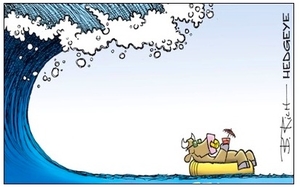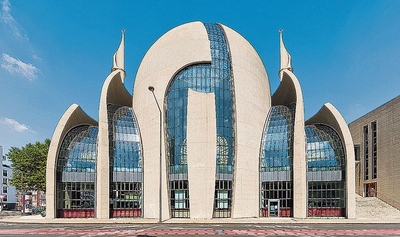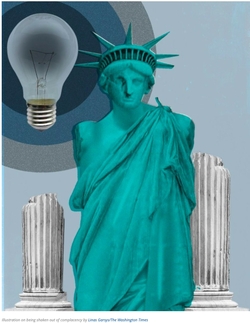 Is there a silver lining to the disruption caused by the COVID-19 virus? Observers note a variety of possible gains, from long-term lower oil prices to improved air quality, from weakened extremist movements to a loosening of unneeded regulations. But these possible benefits pale next to the truly big one: shaking Americans out of their complacency and opening their minds to the potential of catastrophe.
Is there a silver lining to the disruption caused by the COVID-19 virus? Observers note a variety of possible gains, from long-term lower oil prices to improved air quality, from weakened extremist movements to a loosening of unneeded regulations. But these possible benefits pale next to the truly big one: shaking Americans out of their complacency and opening their minds to the potential of catastrophe.
A worldwide virus that has changed nearly everyone's routine and disrupted the economy provides a shocking reminder about the fragility of supply chains, the vulnerability of public health, and the precariousness of democracy. This unsettling experience will have positive consequences if it opens smug minds to the possibility of upheaval. Two existing threats stand out as most likely: electromagnetic pulse (EMP) and the demise of Western civilization.
EMP could spell instantaneous disaster by frying electronics, leaving modern economies paralyzed. As Peter Pry, the former Congressional EMP Commission chief of staff, explains, "If you think the coronavirus is frightening, wait until a solar superstorm or electromagnetic pulse attack blacks-out the national electric grid, collapses the economy and critical infrastructures for food and water, and 9-out-of-10 Americans die of starvation." Note that figure: 90 percent dead.
Two solar superstorms occurred in modern times, 1859 and 1921; a third just missed the Earth in 2012.* Jonathan O'Callaghan writes in Scientific American that another superstorm "is an inevitability in the near future."
 The kind of sun flare that can fry electronics. |
What about an attack? The Congressional EMP Commission found that any of the governments of China, North Korea, Russia, and maybe Iran could carry out an EMP attack on the United States with even a small number of nuclear weapons. This would "cause widespread, long-lasting damage to U.S. critical national infrastructures, to the United States itself as a viable country, and to the survival of a majority of its population."
A mere month ago, most Americans dismissed such an existential threat. Shaken by a medieval-style virus, are we now ready to take it seriously and spend the money – about $1 trillion – to insulate against both solar and enemy actions?
As for Western civilization, it came into existence, Jeffrey Hart of Dartmouth explains, out of "the creative tension between Athens and Jerusalem." It then evolved over two millennia into the world's dominant force, affecting nearly every people in nearly every aspect of life. Modernity, sociologist Rodney Stark argues, is "entirely the product of Western civilization."
Its upward trajectory seemed secure until the outbreak of World War I in 1914, the tragedy that started a rash of wars, revolutions, and ideological furies which bought about today's cultural despondency. Self-doubts, shame about light pigmentation, and guilt over a history of imperialism prompt a majority of Westerners to see themselves as the planet's bane and scourge. From this follow many weaknesses, especially demographic and cultural.
 Kaiser Wilhelm inspected German troops in World War I. |
With the single exception of Israel, no Western country comes close to the 2.1 children per woman needed to maintain a population. If the current Total Fertility Rate of 1.3 children per woman in countries like Spain and Italy holds steady and there is no immigration, their populations of fertile women will diminish to about 60 percent their current size in 2050, 36 percent in 2080, and 22 percent in 2110. Given that birthrates keep plummeting over time, these projections are likely too high.
 Israel is the West's demographic outlier. (With thanks to Alejandro Macarrón Larumbe.) |
But immigration to the West is taking place, especially by Muslims. Impelled by overpopulation, poverty, dictatorships, and civil wars in their homelands, they arrive in the West with a robust sense of religious superiority and cultural confidence. Imposing Islamic mores takes time, but many signs point to a shift now underway, such as cathedral mosques arising in Western capitals, criticism of Islam becoming taboo, polygamy expanding, governments funding for Islamist charities, even changing rules at municipal swimming pools. This process moves ahead as relentlessly and quietly as does the contraction of indigenous populations.
 Western Europe's largest mosque, the DITIB-Zentralmoschee in Cologne. |
Protection against an EMP cataclysm requires only money; sustaining Western civilization, however, requires a major shift in sense of self and of identity. Contrarily, whereas EMP takes place in a moment, cultural evolution moves slowly over decades.
If something unknown just three months ago can reshape our lives and have presumably vast consequences, perhaps Americans are now receptive to the possibility of even greater out-of-the-box dangers. Or must we be surprised by these too? Our chance for planning has arrived; let's make use of it.
Mr. Pipes (DanielPipes.org, @DanielPipes) is president of the Middle East Forum. © 2020 by Daniel Pipes. All rights reserved.
 The Washington Times illustration accompanying this article. |
* I am grateful to a reader for pointing out that a solar storm knocked out the electricity in the entire province of Quebec, Canada, on Mar. 13, 1989.
